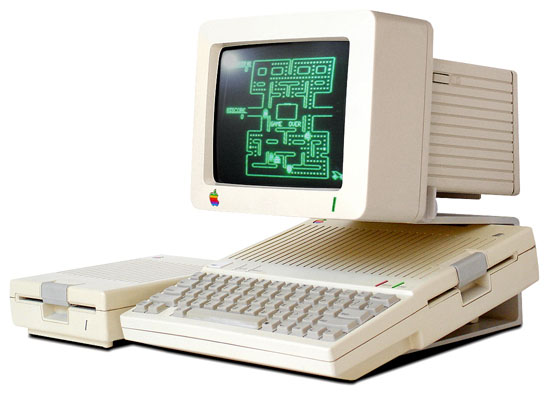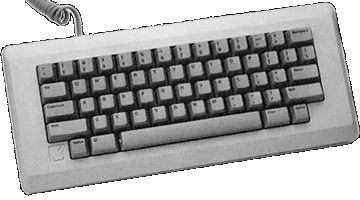Apple //c & //c+

Essentials
Family: Pre-Macintosh
Codename: ET, IIb, IIp, Pippin, VLC, Elf, Yoda, Teddy, Chels, Jason, Lollie
Introduced: April 1984
Terminated: November 1990
Processor
CPU: SynerTek 65C02
CPU Speed: 1 MHz (IIc)/4 MHz (IIc+)
FPU: none
Bus Speed: 1 MHz (IIc)/4 MHz (IIc+)
Register Width: 8-bit
Data Bus Width: 8-bit
Address Bus Width: 16-bit
ROM: 32 kB
Onboard RAM: 128 kB
Maximum RAM: 1 MB (See Notes)
Video
Monitor: Standard 9" Green monochrome, optional LCD panel.
Max Resolution: 40/80 text, 40x40 4-bit, 80x40 4-bit, 140x192 6-color, 280x192 1-bit, 140x192 4-bit, 560x192 1-bit
Video Out: Composite, DB-15
Storage
Floppy Drive: 140 kB 5.25" (IIc)/800 kB 3.5" (IIc+)
Input/Output
Floppy: DB-19
Joystick/Mouse: DE-9
Serial: 2 DIN-5 (IIc)/2 Mini DIN-9 (II
Audio Out: mono mini (IIc only)
Speaker: mono
Miscellaneous
Power: 18 Watts
Dimensions: 2.5" H x 12" W x 11.5" D
Weight: 7.5 lbs.

Notes
The //c was considered a "closed system", and while third-party products allowed users to upgrade their RAM to 1 MB, but only by voiding the warrenty in the process.
Introduced in April of 1984, the Apple //c was the first compact model in the Apple lineup. It came in a small off-white case, and was built around an enhanced 65C02 processor, running at 1.4 MHz. It had 128 kB RAM, (expandable to 1 MB) a built-in 5.25" floppy drive on the side, and could be used with a mouse. The Apple //c+ (pictured right) was introduced in 1988, with a 4 MHz 65C02, RAM expandable to over 1 MB, a larger ROM, and an optional internal 800 kB 3.5" drive. The Apple //c+ was discontinued in November of 1990.
Picture Credits:
Old Computers
Wikipedia
Date: Sun, 15 Apr 2001 18:04:06 -0700
From: Mitchell Spector
Subject: Apple IIc/IIc+ corrections
From a historic viewpoint, I think the most relevent facts would be that there were 5 different IIc ROM revisions (ROM 255, 0, 3, 4 and 5) and three different IIc motherboards (original, memory expandable, IIc Plus).
The original Apple IIc (identified as ROM version '255') could only support a single external 5.25 through its disk port. Early motherboards, specifically those manufactured between April 1984 and December 1984, had faulty serial ports that caused problems with some brands of modems and printer at speeds of 1200 baud or higher (it relied on a 74LS161 to divide the clock for the serial ports, which was 3% too slow. An oscillator on newer mainboards fixed the problem).
The second IIc ROM revision (identified as ROM '0') added support for an external Apple UniDisk 3.5--an 800 kB "dumb" floppy drive. Rudimentary support hooks for an AppleTalk interface were added to the firmware, but later removed from future IIc's when the device was cancelled.
The next two revisions of the IIc (identified as ROM '3' and '4') not only saw a new firmware change, but a slightly redesigned motherboard. The most significant difference was an internal memory expansion socket for plugging in RAM cards (up to 1 MB). Previous versions of the IIc didn't support memory expansion without special tricks and hacks, as there was no such socket. This IIc also came with an improved "clicky" keyboard.
The Apple IIc Plus (identified as ROM '5') was the first IIc model to see significant changes. The three major changes were the internalization of the powersupply (previously an external brick-on-a-rope as users liked to call it), a built-in 800 kB 3.5 floppy drive replacing the older 5.25, and finally, the equivalent of a ZipChip 4 MHz accelerator built-in. Apple licensed the add-on technology from Zip Technologies to incorporate the accelerator as standard in the IIc+, though in doing so, broke it out into an ASIC, SRAM and a faster 65C02 (the ZipChip had all that intergrated into a tall 40-pin DIP chip). Other major changes included a keyboard layout that matched the IIgs and Mac SE, changing of the serial port connectors from DIN-5 to mini DIN-8 and an internal modem connector, although the latter never saw any products to use it.
Some third parties produced hardrives for the IIc and IIc+, although since they communicated through the floppy disk port, they were rather slow. External battery packs and flat panel LCD screens had also been sold for a period of time, helping to make the IIc a true portable to those who could afford these peripherals.
Also of interesting note, the IIc Plus was only sold in the United States (hence the lack of an international version of it).
Mitch
Date: Tue, 02 Aug 2005 19:08:56 -0700
From: Antonio Rodríguez
Subject: Apple //c
The Apple //c was offered by Apple not only with the two displays listed (9" monochrome and LCD), but also was avilable a special RGB 13" monitor in snow white and with a stand to make it fit the //c. It can also be used with any composite monitor, or even with a TV set using the included RF modulator.
The low resolution modes are 4-bit 40x48 and 80x48, not 40x40 and 80x40 as stated.
All models of the //c supported 32 Kb of ROM. The first revision had only 16 Kb, but starting with the "ROM 0", an extra 16 Kb were added, used to include the extra features Mitchell Spector refers to, like 3.5" drive support.
The later revisions of the //c and the //c+ could be expanded *up to* 1 Mb, not *over* 1 Mb. Also, as I said before, the larger ROM were introduced in the //c ROM 0, not on the //c+.
The original //c was the first Apple ][ computer to use the IWM chip, an integrated and upgraded version of Woz's Disk ][ controller. It wasn't the first computer using it, however: it had debuted in the original Macintosh, three months before.
Date: Sat, 22 Dec 2007 12:31:14 -0800
From: David Sibley
Subject: Not White!
"Introduced in April of 1984, the Apple //c was the first compact model in the Apple lineup. It came in a small white case"
As documented in Paul Kunkle's Apple Design, the //c was a creamy off-white color known as "Fog". So off-white would be a better description. Unfortunately most people mis-construe the project name "Snow White" and resulting "design language" as a literal color designation. Many people incorrectly identify the case and peripherals as originally being "white" due to its light color and tendency for Apple plastics to yellow with age.
Also note that the IIc turned Platinum in later models. I thought it coincided with the //c+ in '98 but cannot confirm exactly when it happened.
